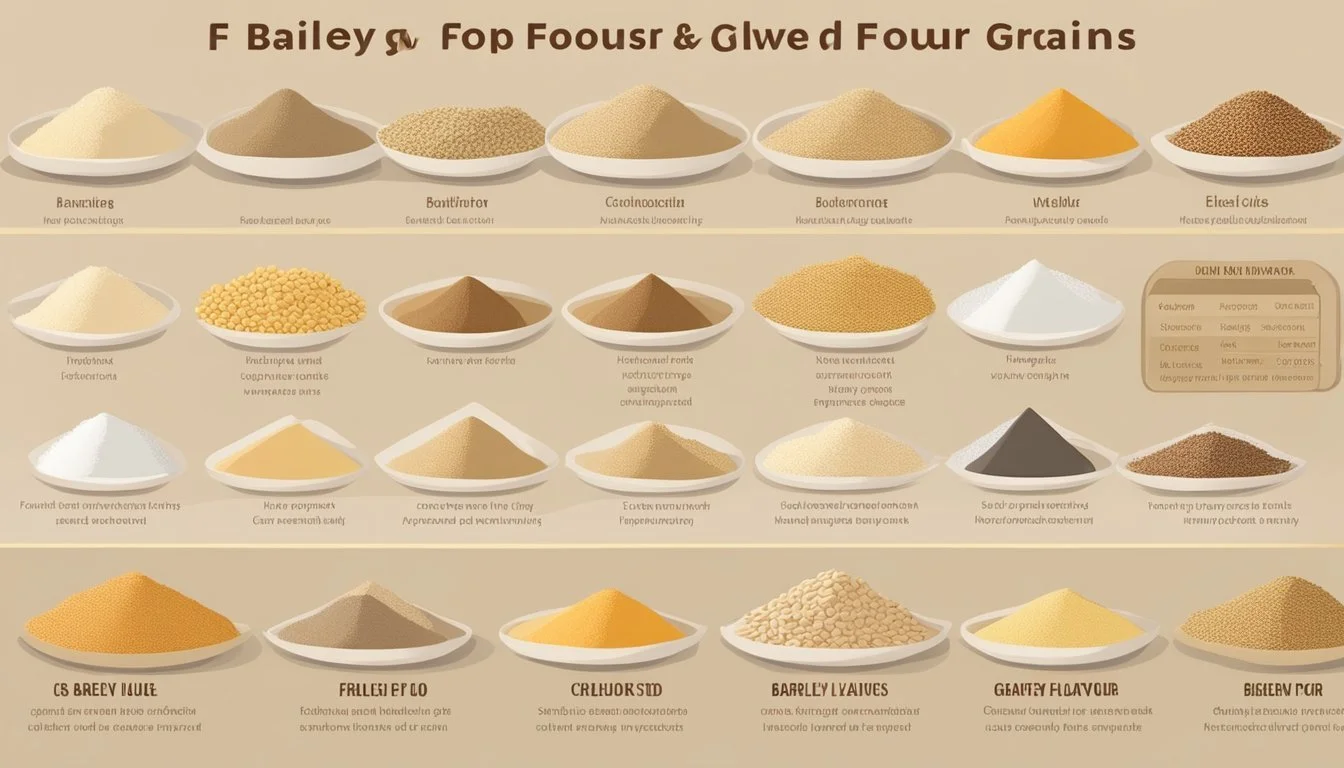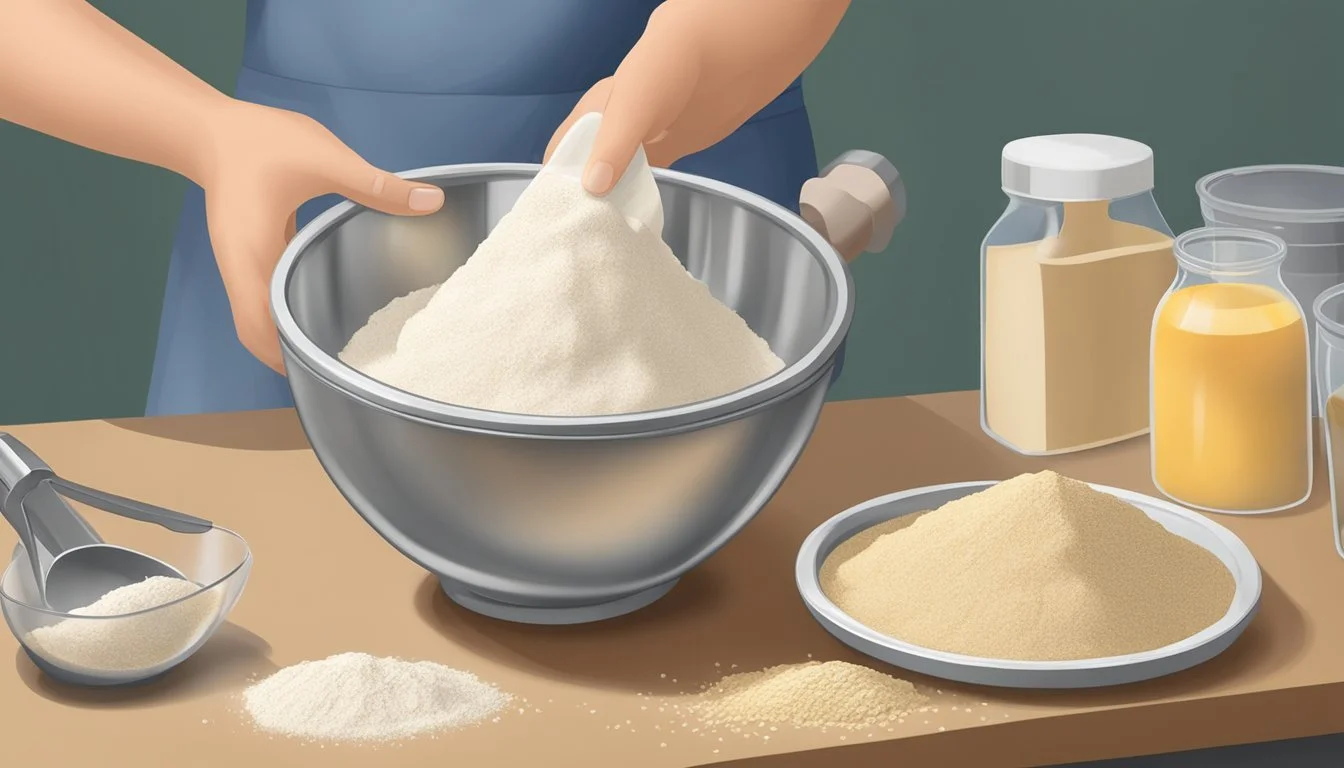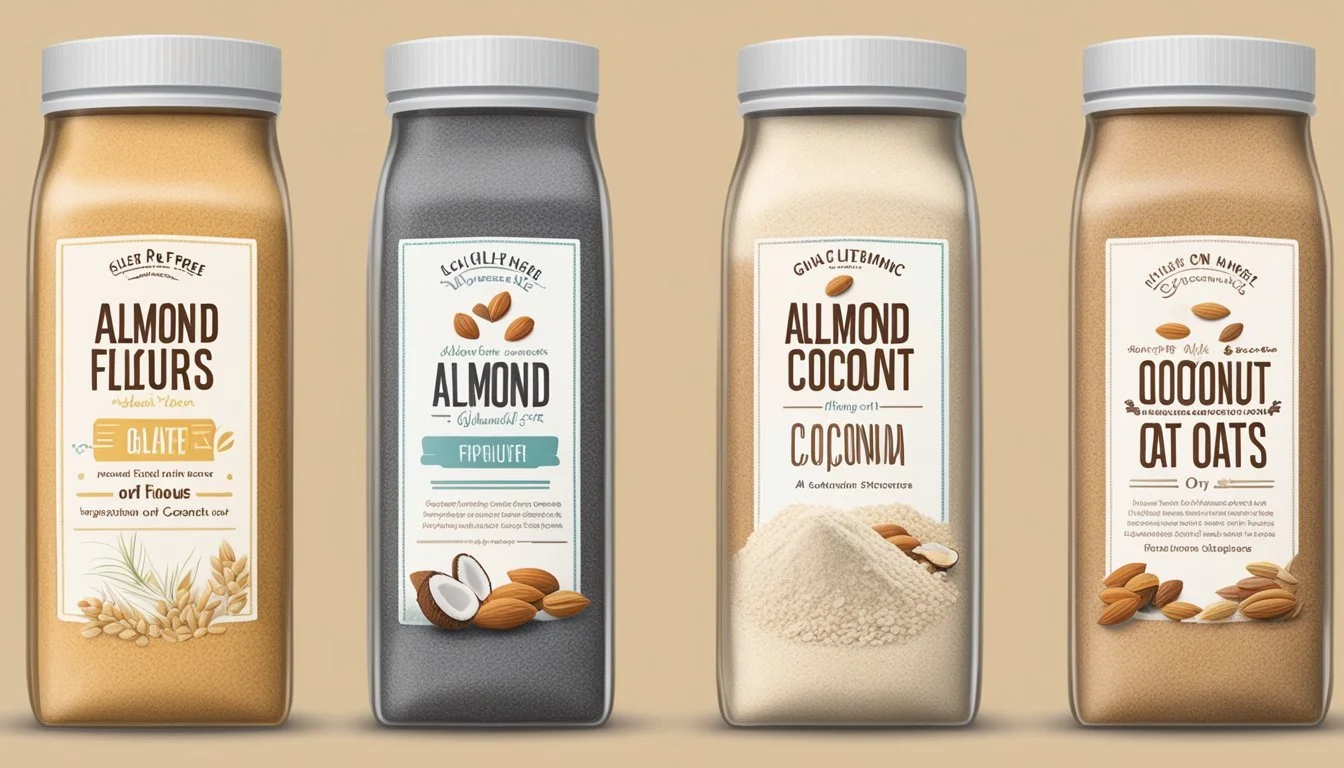Barley Flour Substitutes
Best Alternatives for Baking and Cooking
Finding the right substitute for barley flour can elevate your baking and cooking. Whole wheat flour is a versatile option that can stand in for barley flour in many recipes. It brings a rich, nutty flavor and higher fiber content, making it a healthy alternative for various baked goods.
Another excellent substitute is bread flour, which is derived from hard red spring wheat. Despite its refined nature, bread flour provides a high protein content and is fantastic for creating structure in bread and doughs. For those needing a gluten-free option, tapioca flour is noteworthy: it offers a light, crisp texture suitable for a variety of recipes.
Exploring these substitutions allows for flexibility and innovation in the kitchen, catering to dietary needs and personal preferences. Whether aiming for better nutrition or gluten-free baking, the right choice of flour can make all the difference.
Understanding Barley Flour
Barley flour is produced by grinding whole barley grains, a type of cereal grain that has been cultivated for thousands of years. This flour is known for its mild, nutty flavor and slightly chewy texture.
Barley flour contains a modest amount of gluten, making it unsuitable for those with celiac disease or severe gluten intolerance. Despite this, it is often used in baking and cooking because it adds richness to recipes.
Barley flour is high in fiber, which aids in digestion and contributes to a feeling of fullness. It also contains protein, which helps in building and repairing tissues.
Nutrients and Vitamins
Barley flour is a good source of essential vitamins and minerals. Notably, it is rich in:
B Vitamins (such as niacin and thiamine)
Iron
Magnesium
Phosphorus
These nutrients play crucial roles in maintaining overall health.
Starch Content
This flour has a significant amount of starch, which can be beneficial in recipes that require binding and thickening. The natural starch in barley flour provides a unique texture to baked goods.
Benefits of Whole Grain
Being a whole grain, barley flour retains all parts of the grain kernel: the bran, germ, and endosperm. This ensures that it maintains its nutritional profile, making it a healthier option compared to refined flours.
Incorporating barley flour into your diet can be a nutritious choice due to its rich content in fiber, protein, and essential nutrients. It can be used in a variety of recipes, including flatbreads, muffins, and other baked goods.
Benefits and Uses of Barley Flour
Barley flour is known for its nutritious qualities, offering various health benefits and culinary uses.
Fiber content: Barley flour is rich in both insoluble and soluble fiber, which promotes digestive health, helps regulate blood sugar levels, and may lower cholesterol. For those managing diabetes, it can be a valuable addition to their diet.
Protein: With a higher protein content than many other flours, barley flour provides essential amino acids that are important for muscle building and repair.
In baking, barley flour can contribute a mild, nutty flavor to baked goods. It can be used to make various items, including flatbreads, cookies, and muffins. Though it contains some gluten, it does not provide the same rise as wheat flour.
Comparison Table: Fiber Content (per ¼ cup):
Flour Type Fiber Content (grams) Barley Flour 3 Spelt Flour 4 Red Whole Wheat 5
Barley flour is a versatile ingredient in many recipes. It can easily be incorporated into daily meals to enhance their nutritional profile.
Common Barley Flour Substitutes
Several options can replace barley flour, depending on dietary needs and the type of recipe. Both wheat-based and gluten-free alternatives are available for those with gluten sensitivities or specific baking requirements.
Wheat-Based Substitutes
All-Purpose Flour
All-purpose flour is a popular substitute for barley flour. It is widely available and affordable. It works well in bread, pancakes, cookies, and other baked goods. Being higher in protein, it may require slightly more liquid to achieve the desired consistency when substituting.
Whole Wheat Flour
Whole wheat flour provides a denser texture and adds a nutty flavor, similar to barley flour. It's an excellent choice for hearty bread and muffins. This substitute is higher in fiber, making it a healthier option for those looking to increase their dietary fiber intake.
Bread Flour
Bread flour has a higher protein content, which gives more structure to baked goods like pizza dough and yeast bread. It also has a milder taste, making it suitable for various recipes. The increased gluten content helps in the elasticity and rise of the dough.
Gluten-Free Substitutes
Rice flour is a versatile gluten-free alternative to barley flour. It is commonly used in baked goods and has a mild flavor. This flour can be used in a 1:1 ratio but may need a binding agent like xanthan gum to achieve the best results.
Buckwheat flour is another gluten-free option with a strong, nutty flavor. It is suitable for pancakes, muffins, and other dense baked goods. Despite its name, buckwheat is not related to wheat and is safe for those with gluten allergies or celiac disease.
Almond flour is a popular gluten-free substitute, known for its rich, moist texture. It works well in cookies, cakes, and quick breads. This flour adds a sweet, nutty flavor and is also low in carbohydrates, making it suitable for keto diets and those with gluten intolerance.
Criteria for Choosing a Substitute
Selecting the right substitute for barley flour involves considering various factors. Key elements include nutritional content, flavor and texture, and how the substitute behaves in baking and cooking.
Nutritional Considerations
Nutritional composition is a primary factor. Protein content is important, especially for those needing structure in baked goods. Bread flour, for example, has high protein levels, making it suitable for doughs needing more strength.
Fiber content should also be examined. Flours like spelt and red whole wheat provide more fiber compared to barley flour. Barley flour contains 3 grams of fiber per ¼ cup, while spelt offers 4 grams and red whole wheat about 5 grams per ¼ cup.
Additionally, gluten content is crucial for individuals with dietary restrictions. Substitutes such as tapioca flour offer a gluten-free alternative. Understanding the balances of these nutritional components helps ensure the substitute matches the dietary and baking needs.
Flavor and Texture Profile
Barley flour has a distinct taste and texture that affects the final product's outcome. It provides a mild, nutty flavor that is desirable in many baked goods. A substitute should have a compatible flavor profile to maintain the desired taste. Oat flour and almond flour are good examples as they offer similar nutty notes.
The texture is another consideration. Barley flour adds moisture and a chewy texture, particularly to cookies and bread. Flour like buckwheat or almond flour can mimic this moistness and chewiness. Using flour substitutes that align closely with barley flour's texture helps in achieving the desired consistency and mouthfeel.
Baking and Cooking Behaviors
Understanding how substitutes behave during baking or cooking is essential. Barley flour contributes structure and lift, which affects the rise and stability of baked goods. Bread flour with its high protein can provide similar structural benefits, but it contains gluten, making it unsuitable for gluten-free needs.
Cooking time can change when using different flours. Flours like coconut flour absorb more liquid and thus, alter cooking times and consistency. Measuring substitutes accurately is also key. Weighing flour rather than using volume measurements ensures precision and consistency, crucial for successful baking outcomes.
Finally, the correct ratio of substitution must be known. While some flours can be used one-for-one, others might require adjustment to achieve the right balance in recipes. Properly understanding these aspects helps in making an informed decision when substituting barley flour.
Grain-Based Substitutes
Grain-based substitutes for barley flour include nutrient-rich options such as quinoa, millet, and various types of rice. These alternatives not only provide similar textures and flavors but also bring their unique nutritional profiles to enhance any recipe.
Quinoa and Millet
Quinoa is a versatile grain that has gained popularity due to its high protein content and array of vitamins and minerals. It is gluten-free and works well in both sweet and savory dishes. Quinoa adds a slight nutty flavor and moist texture to baked goods, making it a fantastic replacement for barley flour.
Millet is another excellent substitute due to its mild flavor and versatility. This ancient grain is rich in magnesium, phosphorus, and other nutrients. It can be ground into flour and used in baking, providing a light, tender crumb in bread and pastries. Both quinoa and millet are suitable for those with gluten sensitivities, offering nutritious and delicious alternatives to barley flour.
Rice Varieties
Brown rice is a whole grain that offers a nutty flavor and dense texture, suitable for replacing barley flour in a variety of recipes. It is rich in fiber, vitamins, and minerals, making it a healthful alternative. Brown rice flour can be used in baked goods to add moisture and a hearty texture.
White rice, on the other hand, has a milder flavor and a finer texture. It can be used to create lighter baked goods. While it is less nutrient-dense than brown rice, it offers a versatile base that can blend seamlessly into many recipes. Both types of rice provide gluten-free options for those looking to substitute barley flour.
Other Nutritious Grains
Farro is an ancient grain known for its chewy texture and nutty flavor. It is not gluten-free but is much lower in gluten than modern wheat. Farro flour can bring added texture and flavor to bread and pastries, making it an interesting alternative to barley flour.
Sorghum is a nutrient-rich grain that is naturally gluten-free. It has a sweet, mild flavor and provides similar binding properties in baking. Sorghum flour can be used in a variety of recipes from breads to desserts, offering a healthful substitute for barley flour.
These grain-based substitutes ensure that you don't have to compromise on taste or texture when looking to replace barley flour in your recipes. Each grain brings its unique qualities to the table, enhancing the nutritional value and culinary experience.
Other Flour Substitutes and Their Properties
Various alternatives to barley flour exist, each with unique properties that cater to different dietary needs and culinary applications. These substitutes include options derived from nuts, roots, and non-cereal grains.
Nut and Root Flours
Almond Flour: Made from finely ground almonds, almond flour is rich in healthy fats and proteins. It is gluten-free, making it suitable for those with gluten intolerance. Its slightly sweet flavor enhances baked goods like cookies and pastries. However, its high fat content may require adjustments in recipes to avoid overly dense results.
Tapioca Flour: Derived from cassava root, tapioca flour is another gluten-free option. It has a neutral taste and is often used as a thickening agent in soups and sauces. It gives baked goods a chewy texture and improves moisture retention. Tapioca flour is particularly effective when used in combination with other flours to enhance the final product.
Potato Flour: This flour, made from cooked, dried, and ground potatoes, offers a binding quality that enhances the texture of bread and pastries. It also helps retain moisture, making baked goods softer and extending their shelf life. Potato flour is gluten-free and adds a subtle potato flavor to recipes.
Non-Cereal Grain Flours
Buckwheat Flour: Despite its name, buckwheat is not a grain but a seed, making buckwheat flour gluten-free. It has a strong, earthy flavor that pairs well with hearty baking recipes like pancakes and muffins. Buckwheat is also high in fiber and essential amino acids, offering nutritional benefits to baked goods.
Corn Flour: Made from finely ground cornmeal, corn flour is a versatile substitute that provides a slightly sweet, earthy flavor. It can be used in a variety of recipes, from bread to tortillas. The flour is gluten-free and imparts a crumbly texture, making it ideal for cornbread and other dense baked goods.
These flour substitutes offer diverse options for baking and cooking, each bringing specific attributes to enhance both the nutritional profile and the textural quality of various dishes.
Adjusting Recipes for Substitute Flours
When substituting barley flour with other flours, it’s important to adjust recipes to maintain the desired texture, flavor, and structure of the final product. Different flours have varying properties which affect rise, elasticity, and moisture levels.
Breads and Pastries
For breads and pastries, the choice of flour impacts the dough's elasticity and rise. Barley flour has low gluten content, so using bread flour as a substitute can help replicate the structure due to its higher protein content.
Almond flour can also be used but will require adjustments, such as increasing the number of eggs for binding. Coconut flour, with its high absorbency, needs more liquid and eggs to prevent dryness.
Cakes and Muffins
In cakes and muffins, barley flour contributes to a tender crumb and mild flavor. Replacing it with flours like whole wheat flour or spelt flour can provide a similar nutritional boost and texture.
Since these flours are denser, the recipe might require additional leavening agents like baking powder or soda. Tapioca flour is another option, offering a light and crisp texture, though it may need to be combined with other flours to avoid excessive chewiness.
Pancakes and Side Dishes
For pancakes and side dishes, the flour substitution must balance moisture absorption and flavor. Flaxseed meal can replace barley flour but will require additional liquid to prevent the batter from becoming too thick.
Farro flour and red whole wheat flour are high-fiber substitutes that can enhance the flavor and nutritional profile of pancakes and casseroles. When using coconut flour, increase eggs and liquid to achieve the right consistency and avoid dryness. Be mindful that some flours, such as tapioca, need to be mixed with other flours to achieve an appropriate texture.
Special Considerations for Dietary Restrictions
When choosing a barley flour substitute, it's important to consider any dietary restrictions such as gluten intolerance and diabetes. This ensures the substitutions used meet specific health needs without compromising taste and texture.
Gluten Intolerance and Celiac Disease
For individuals with gluten intolerance or celiac disease, selecting a gluten-free substitute for barley flour is crucial. Sorghum flour is an excellent choice as it provides a hearty texture and mild, nutty flavor while being naturally gluten-free.
Cauliflower rice can also be used, particularly in dishes like pilafs and stir-fries. Though it won't replicate the exact texture of barley, it absorbs flavors well. Almond flour and coconut flour are other alternatives that are both gluten-free and nutritious. When using these flour types, it's essential to follow proper measuring techniques to ensure consistency in recipes.
Low-Glycemic Options for Diabetics
For those managing diabetes, low-glycemic substitutes for barley flour are highly beneficial. Almond flour is a low-glycemic option that provides a good source of protein and healthy fats. This helps maintain a steady blood sugar level.
Chickpea flour is another substitute that boasts a low glycemic index. It is rich in protein and fiber, making it a suitable option for diabetic-friendly baking and cooking.
Incorporating these alternatives into recipes can help manage blood sugar levels while maintaining a nutritious and satisfying diet. By selecting the appropriate substitutes, those with dietary restrictions can enjoy a wide variety of dishes without compromising their health.
Conclusion
Barley flour substitutes are both versatile and nutritious. When looking for an alternative, consider the recipe requirements and desired nutritional benefits.
For instance, whole wheat flour is often used due to its fiber content. Spelt flour is another choice, known for its slightly sweet flavor and moderate gluten.
Substitutes like quinoa flour and brown rice flour cater to those needing gluten-free options. These options maintain the nutrient richness barley flour offers while accommodating dietary restrictions.
Using bread flour can be a good move for those seeking higher protein content, although it may lack some nutrients found in whole grain flours. Explore these options to find the best match for your baking needs.
Here is a quick reference table for popular substitutes:
Substitute Notable Features Whole Wheat Flour High in fiber Spelt Flour Sweet flavor, moderate gluten Quinoa Flour Gluten-free, protein-rich Brown Rice Flour Gluten-free, mild taste Bread Flour High protein content
Each of these flours offers unique benefits, making them adaptable for various recipes while retaining essential nutrients. The choice depends on individual needs and specific baking goals.








